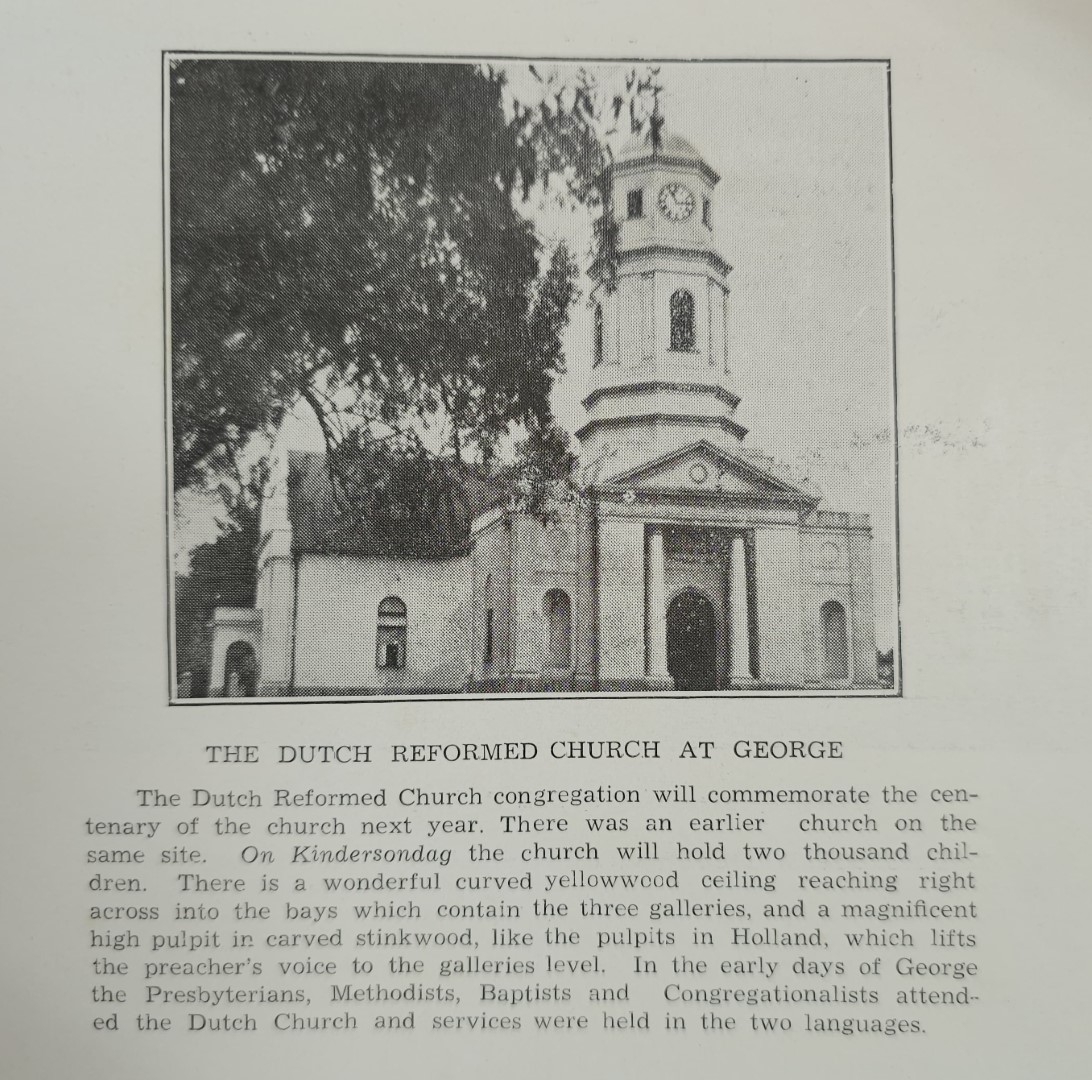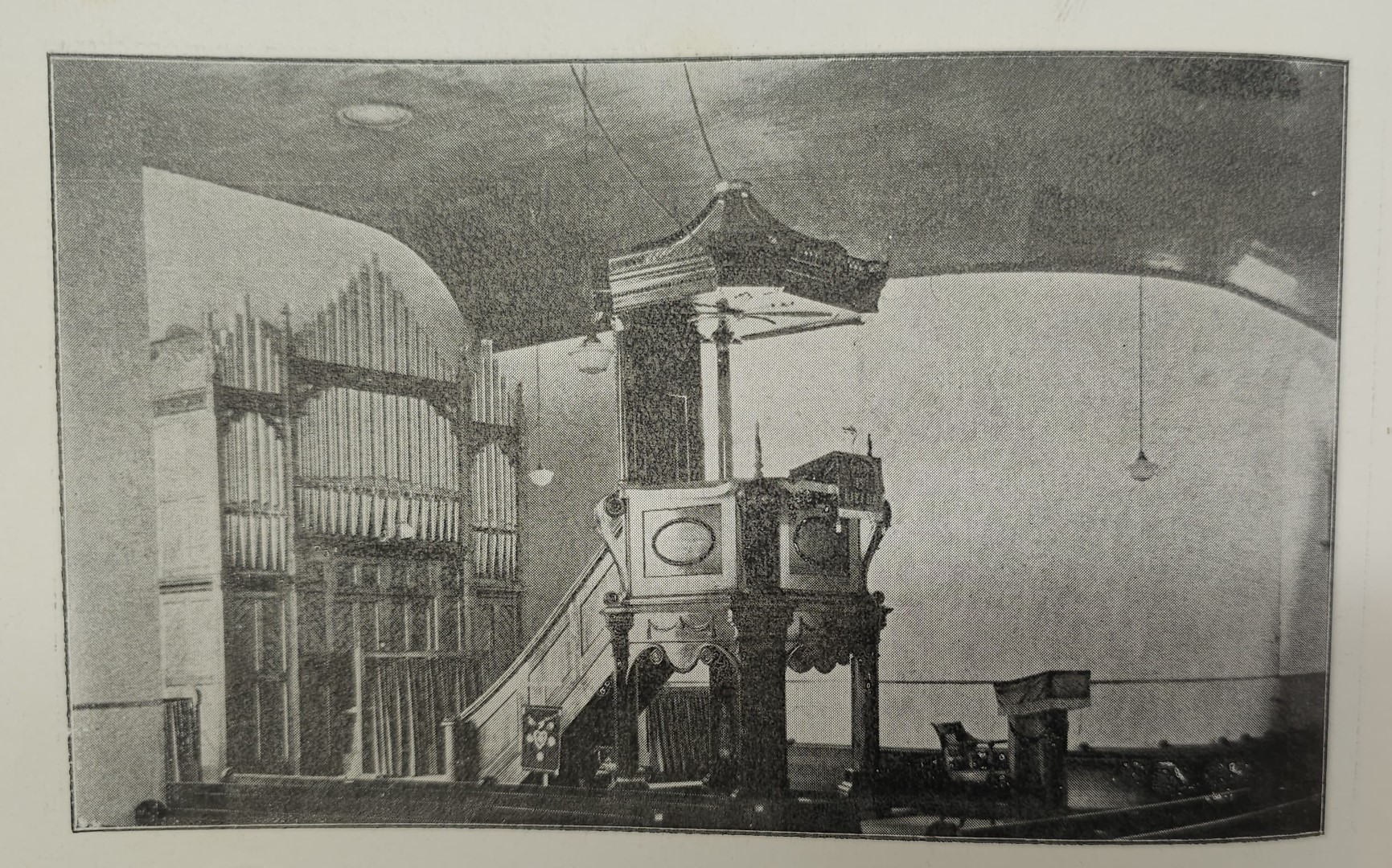GEORGE NEWS - In nearly all the rural towns of this country the Dutch Reformed Church has the largest and most important building. In 1811 the village and district of George had been founded, and shortly afterwards it was the centre of a congregation.
In 1812, the Rev. Tobias Johannes Herold, a young colonist who had just returned from completing his studies in Europe, was appointed clergyman of George, but was not required to assume the duty until a parsonage could be built.
Landdrost Van Kervel nominated the first elders and deacons, who were formerly approved by the governor on the 9th of February, 1813. In those days the church was governed directly by the State.
The ministers were appointed by the governor and their salaries paid by the State. Up till Dec 1843 all elders and deacons had to be approved by the governor. On the 25th of April, 1813, Mr. Herold started his work at George, and for the first few months services were held, and the minister lived at Sandkraal, which farm had been hired for the purpose from Mr C. F. Pohl.
Meeting in old Posthouse
The first meeting of the Kerkraad was held in the old Posthouse on the 9th May, 1813. The records of these first meetings of the Kerkraad we fortunately have still, very neatly written, in the handwriting of the minister himself. Landdrost Van Kervel appears to have assisted the minister in all possible ways, and at the first meeting the minister reported that the landdrost had kindly ordered the old Posthouse to be brought in readiness for services as it would be more suitable for the people of the village.
At this first meeting a sextion was appointed in the person of J. W. Paulsen, but on condition that he should assist the public schoolmaster and voorlezer, A. van de Colff, in leading the singing. It may be pointed out that in those days all the congregations had a voorlezer and a voorsinger.
The former had to read all the announcements, the portion out of the Bible, etc., whereas the latter had always to start the hymns and lead the singing, and woe betide the man or woman who dared to start a hymn when the voorsinger was present, or who drowned the voice of the voorsinger by singing too loudly, for he was very jealous of his prerogative.
At the second meeting of the Kerkraad held on the 1st of August, 1813, deacon Rademeyer brought forward a complaint of two members of the congregation, viz., Nel and Olivier, living along the Olifants River, that they could not attend the church services because they did not have the money continually to pay for the toll.
Interview with landdrost
A committee of the Kerkraad was appointed to interview the landdrost, to try and persuade him to remit the toll money for those who came to attend divine service. Van Kervel appears to have possessed a keen knowledge of human nature, for at the third meeting, in October, 1813, the committee reported that the landdrost had agreed to the request to remit the toll money, but on condition that on repassing the toll gate, when leaving the town they had to show a certificate signed by one of the deacons that they had actually attended the service in the church.
The first church was built on the same spot where the church today stands. The builder and contractor was a certain mason by the name of F. Trenk.
Poor contractor
The governor did not agree to the request of the Kerkraad to enlarge the church but in the minutes of the 30th of September 1815 we find that the new governor, Lord Charles Somerset, had given instructions to Landdrost Van Kervel to enlarge both the parsonage and the church, and that Trenk had undertaken the whole contract for 32 400 riksdalers.
He seemed to have been a poor contractor, however, and was always in need of money so that the work was continually at a standstill. Finally, on the 2nd of March, 1817, the new church was opened.
Lightning damage
On the 9th of March, 1818, the front part of the church was damaged by lightning and there was more trouble with Trenk about repairing this. At practically every meeting the deplorable state of the building was mentioned, until at the meeting on the 9th of January, 1829, it was reported that people refused to attend divine service because they feared that the building might collapse at any time.
On the 3rd of July, 1820, it was decided to break down the church and to put up a long building behind the parsonage, 80 ft. by 18 to act as a temporary church building, and which might be used as stables and outhouses by the minister. This building, which is there today, was completed in March 1821, and was built by Mr. C. F Pohl.
In the same year proposals were made for the building of a permanent new church, but as funds were not available, the matter was left in abeyance. On the 7th of July, 1823, the Rev. T. Herold notified the Kenkraad that he had been requested by the Governor, Lord Charles Somerset, to leave George and to become minister of the congregation at Paarl.
For a number of years the congregation was without a minister, until on the 31st of May, 1827, the Rev. John Stephen Simeon Ballot was appointed clergyman of George. He was the son of Hendrik Willem Ballot who had come out to South Africa from Iserlohn in 1797, and his second wife Elizabeth van Cruywagen. Mr. Ballot remained at George for 35 years, until he retired on pension in September 1862.
 This photo and caption appeared in the booklet 'The early days of George and the romance of Outeniqualand' published in 1941 by the George & Knysna Herald.
This photo and caption appeared in the booklet 'The early days of George and the romance of Outeniqualand' published in 1941 by the George & Knysna Herald.
New church
On the 26th of December, 1831, a contract was entered into with Mr. C. P. Visser for the building of a new church, but the work proceeded slowly and in 1839 the contract was cancelled on account of lack of funds, the Kerkraad agreeing to pay Visser 800 riksdalers as compensation. A little later tenders were again asked to complete the building and Visser once more got the tender, and in 1842 the church was completed. It is also related that on the very day of the opening of the new church, the builder, Visser, whilst ready dressed to attend the ceremony fell from his loft and was killed. The beautiful pulpit, which is much admired today still, was made by a certain H. Heyne, who Mr. Ballot got to do the work.
Opening ceremony
In 1842 the new church was completed and great preparations were made for the opening ceremony. Mr. Ballot, who was a great lover of music, was quite determined to have some music to celebrate the occasion, for he felt that without music the opening would not be a success. The trouble was where to get the music for the church had no organ.
He was not to be beaten, however, for at Stellenbosch he had a good friend by the name of Pieter Hugo, who was the leader of an excellent brass band consisting of about a dozen music-loving young men. So Mr. Ballot asked this friend to come to his assistance and he promised to do so.
They obtained a wagon drawn by eight horses, and after a journey which lasted six days, reached George in safety.
Cordial reception
Their reception at George was most cordial, and from far and wide people came, not only for the opening of the church, but also to hear the famous band. A programme had to be drawn up for the occasion, and when Mr. Ballot mentioned Hugo's Brass Band the other ministers and members of the Kerkraad almost unamymously opposed the bringing of such music into a church.
It was against the teaching of the Bible, it was ungodly, it was sacrilege and could never be allowed. When the bandmaster heard of this he wanted to pack up and return to Stellenbosch immediately, but he was prevented by Mr. Ballot, who summoned a second meeting.
At this meeting a compromise was arrived at, viz. that the band should not play in the church, but in the entrance Hugo and his band took up their positions in the hall, and when the ministers with the elders and deacons entered the church the band struck up with the well-known hymn: "Gaat tot Zijn poorten in met lof" ("Enter ye His gates with praise").
The effect was irresistible, even the old opponents of the band could not withhold their tears, and at the next service the band was invited into the church, and after their rendering of Psalm 82, all prejudice had disappeared.
(This article was published by George & Knysna Herald in 1941 in its 60th year of existence as a commemoration booklet titled 'The early days of George and the romance of Outeniqualand'.)

The high pulpit in the Dutch Church was done by a certain H. Heyne who was appointed to undertake the work by the Rev. Johan Stephen Simeon Ballot, the clergyman at George for 35 years, from 1827 until he retired on pension in 1862.
‘We bring you the latest Garden Route, Hessequa, Karoo news’
















